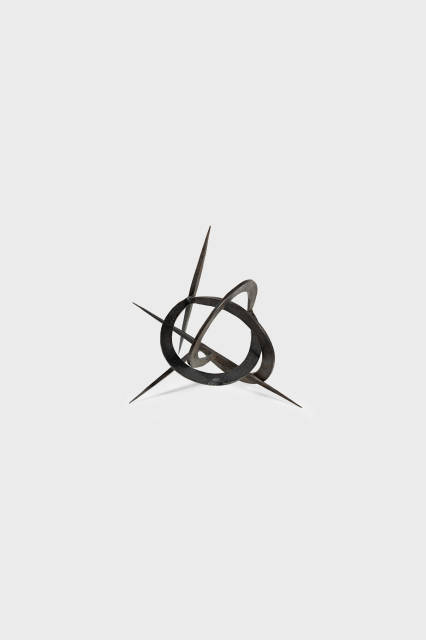- EN
Log in
- Live Auctions
- Past auctions
- More
- Gallery
- Art Dealing
- Publishing
- Kornfeld today
- The Story of Kornfeld
- Information









1924 San Sebastián 2002
Sale time 13-09-2024,
about 15:25 h (CET)
(+/- 30 min)
1954
Forged iron
50x50x25 cm
With the struck monogram right on the reverse
Ignacio Chillida/Alberto Cobo, Eduardo Chillida, Catalogue raisonné of Sculpture, San Sebastián 2014, no. 1954005
Collection Anna Blankart, 1987 by inheritance to
Private collection Switzerland
Pierre Volboudt, Chillida, Barcelona 1967, no. 10
Claude Esteban, Chillida, Paris 1971, no. 11
Jutta Held, Jahrbuch der Hamburger Kunstsammlungen, vol. 20, Hamburg 1975, p. 104
María de la Soledad Álvarez Martínez, Escultors contemporáneos de Guipúzcoa 1930-1980, medio siglo de una Escuela Vasca de Escultura, Donostia-San Sebastián 1981, p. 430
Kosme María de Barañano, La obra artística de Eduardo Chillida, Bilbao 1988, p. 58
Kosme María de Barañano/Ina Busch/Matthias Bärmann/Tomás Lllorens/José Ángel Valente, Chillida 1948-1998, Madrid 1999, p. 70
Javier Lomelí Ponce, El límite como concepto plástico en la obre de Eduardo Chillida, Barcelona 2011, p. 165
Paris 1956, Galerie Maeght, Chillida
Basel 1962, Kunsthalle, Eduardo Chillida, cat. no. 8 (labelled "Musique des constellations" and dated 1955)
Pittsburgh 1979-1980, Museum of Art, Carnegie Institute, Chillida, cat. no. 27 (also labelled "Music of the Constellations", "Musique des constellations" and "Music of the Constellations")
Donostia-San Sebastián 1992, Palacio di Miramar, Chillida en San Sebastián, cat. no. 72
Bad Homburg v.d.H. 1997, Sinclair House, Chillida und die Musik, cat. no. 4
An original flaw in the iron at the bottom front in the rounding. A repair to the weld seam at the centre back, probably blackened later. In very good and original condition
After studying architecture in Madrid, Eduardo Chillida moved to Paris in 1948 and set up his first studio. There he worked on figurative sculptures made of plaster and clay. In 1951/1952, he returned to Hernani in the Basque country with his wife Pilar Belzune and began working on iron sculptures in Manuel Illarramendi's forge. After moving into a large house, a forge became an integral part of his studio. The early sculptures created there have an incredibly dynamic effect, the artist explores possibilities and develops his unmistakable iconography, which forms the basis for his later large iron sculptures.
The works from this early period, such as the sculpture "Música de las constelaciones" ("Music of the Constellations") from 1954 offered here, are still much more delicate and light in comparison to later works, but also bear witness to power and violence.
1954
Geschmiedetes Eisen
50x50x25 cm
Rückseitig rechts mit dem geschlagenem Monogramm
Ignacio Chillida/Alberto Cobo, Eduardo Chillida, Catalogue raisonné of Sculpture, San Sebastián 2014,
Slg. Anna Blankart, 1987 durch Erbschaft an
Privatsammlung Schweiz
Pierre Volboudt, Chillida, Barcelona 1967,
Claude Esteban, Chillida, Paris 1971,
Jutta Held, Jahrbuch der Hamburger Kunstsammlungen, Bd. 20, Hamburg 1975,
María de la Soledad Álvarez Martínez, Escultors contemporáneos de Guipúzcoa 1930-1980, medio siglo de una Escuela Vasca de Escultura, Donostia-San Sebastián 1981,
Kosme María de Barañano, La obra artística de Eduardo Chillida, Bilbao 1988,
Kosme María de Barañano/Ina Busch/Matthias Bärmann/Tomás Lllorens/José Ángel Valente, Chillida 1948-1998, Madrid 1999,
Javier Lomelí Ponce, El límite como concepto plástico en la obre de Eduardo Chillida, Barcelona 2011,
Paris 1956, Galerie Maeght, Chillida
Basel 1962, Kunsthalle, Eduardo Chillida,
Pittsburgh 1979-1980, Museum of Art, Carnegie Institute, Chillida,
Donostia-San Sebastián 1992, Palacio di Miramar, Chillida en San Sebastián,
Bad Homburg v.d.H. 1997, Sinclair House, Chillida und die Musik,
Unten vorne in der Rundung eine ursprüngliche Fehlstelle im Eisen. Hinten mittig wohl eine nachträglich geschwärzte Reparatur der Schweissnaht. In sehr guter und ursprünglicher Erhaltung
Nach einem Architekturstudium in Madrid zog Eduardo Chillida 1948 nach Paris und richtete sich ein erstes Atelier ein. Er arbeitete dort an figürlichen Plastiken aus Gips und Ton. 1951/1952 kehrte er mit seiner Gattin Pilar Belzune nach Hernani ins Baskenland zurück und begann sich in der Schmiede von Manuel Illarramendi mit Eisenplastiken zu befassen. Nach Bezug eines grossen Hauses wurde eine Schmiede fester Bestandteil seines Ateliers. Die dort entstandenen frühen Plastiken wirken ungemein dynamisch, der Künstler lotet Möglichkeiten aus und entwickelt dabei seine unverkennbare Ikonographie, die die Grundlage zu seinen späteren grossen Eisenplastiken bilden.
Die aus dieser Frühzeit stammenden Werke, wie die hier angebotene Plastik "Música de las constelaciones" (Musik der Sternbilder) von 1954, sind im Vergleich zu später entstandenen Arbeiten noch viel filigraner und von grosser Leichtigkeit, zeugen aber auch von Kraft und Gewalt.
| Switzerland | CHF | Individual offer |
| Europe | CHF | Individual offer |
| Overseas | CHF | Individual offer |










